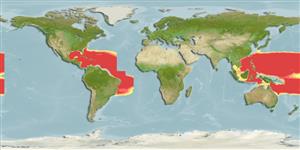Teleostei (teleosts) >
Trachichthyiformes (Roughies) >
Anoplogastridae (Fangtooths)
Etymology: Anoplogaster: Greek, ana = up + Greek, oplon = shield + Greek, gaster = stomach (Ref. 45335); brachycera: From the main characters of the young specimens which have short temporal and pre-opercular spines.
Environment: milieu / climate zone / depth range / distribution range
Ecology
Marine; bathypelagic; depth range 0 - 1500 m (Ref. 31253). Deep-water
Pacific and Atlantic: tropical waters, from the Sulu Sea in the western Pacific and from the Gulf of Mexico to north of the Bahamas Islands in the western Atlantic (Ref. 50735); off southeastern USA (Moore, pers. comm.).
Size / Weight / Age
Maturity: Lm ? range ? - ? cm
Max length : 6.0 cm SL male/unsexed; (Ref. 31253)
Minimum depth from Ref. 58018.
Life cycle and mating behavior
Maturity | Reproduction | Spawning | Eggs | Fecundity | Larvae
Paxton, J.R., 1999. Order Beryciformes. Anoplogastridae. Fangtooths. p. 2210. In K.E. Carpenter and V.H. Niem (eds.) FAO species identification guide for fishery purposes. The living marine resources of the WCP. Vol. 4. Bony fishes part 2 (Mugilidae to Carangidae). FAO, Rome. (Ref. 9852)
IUCN Red List Status (Ref. 130435: Version 2024-1)
Threat to humans
Harmless
Human uses
Fisheries: of no interest
Tools
Special reports
Download XML
Internet sources
Estimates based on models
Preferred temperature (Ref.
123201): 7.2 - 18.9, mean 11.1 °C (based on 563 cells).
Phylogenetic diversity index (Ref.
82804): PD
50 = 1.0000 [Uniqueness, from 0.5 = low to 2.0 = high].
Bayesian length-weight: a=0.01995 (0.00906 - 0.04395), b=3.01 (2.83 - 3.19), in cm total length, based on all LWR estimates for this body shape (Ref.
93245).
Trophic level (Ref.
69278): 3.3 ±0.5 se; based on size and trophs of closest relatives
Fishing Vulnerability (Ref.
59153): Low vulnerability (10 of 100).
